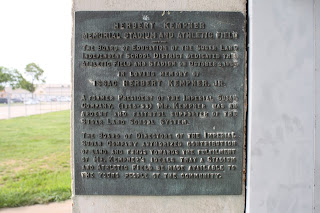I had a very enjoyable visit with Mr. Tom B. McDade, Jr. (SLHS Class of 1940) and his wife last week. The object of his visit was to give me some records his father kept of cotton harvests in Sugar Land from 1928 to 1942. After I've scanned them, I will put them in the Sugar Land Heritage Foundation's document collection. (I'll have more on them in the future.)
As I said, we had a very pleasant visit and talked about all kinds of things. Here are a few other items he's donated to the SLHF. These relate to his high school graduation class.
SLHS 1940 Commencement Program.
SLHS 1940 Commencement Program.
SLHS 1940 Baccalaureate Program.
SLHS 1940 Baccalaureate Program.
SLHS 1940 Class Photo.
Cherryl Hughes Fikes has generously given me a scan of the class photo, which I posted earlier. You see her father, Joe Bob Hughes, among the members of the Class of '40. I wanted to post it again due to an astounding story Mr. McDade told me.
He was in the US Navy during WWII. He served as an officer on an LCI (landing craft infantry) in the Pacific theater of war. He was on leave in the Philippines and went to an air base where he met his classmate, Joe Bob Hughes, by chance. Hughes was a B-29 pilot and suggested Tom join him on a trip to Okinawa. Tom thought about it, but decided it was probably better that he decline. As it turned out, he made the right decision. A day or two later a monster typhoon hit Okinawa. He would have had some 'splanin' to do regarding how he was stranded in Okinawa!
What astounds me is this is the 5th story I've heard about Sugar Land men/boys meeting up with each other in the Pacific theater during WWII. (I know at least one occurred in Europe.) Like my mother has said, the population of Sugar Land was about 2,500 people, yet in all but one, the meetings happened by chance.
























